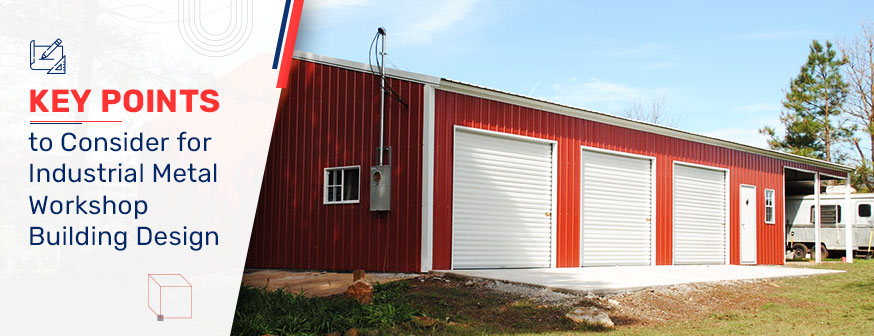How to Ventilate Your Metal Building
 December 26, 2023
Posted in: Metal Buildings
December 26, 2023
Posted in: Metal Buildings

Inhale, Exhale, Excel with Your Metal Building
Metal buildings are an all-around great way to keep your vehicles, equipment, and valuables safe from the elements. They’re also a cost-effective way to give yourself space for projects and hobbies. But a well-functioning metal building will likely require ample ventilation.
While ventilation can be achieved passively by introducing windows and doors to your building design, sometimes that’s not enough. When working with harsh chemicals or with certain equipment, having plenty of airflow is a necessity.
So, if you’re asking yourself what’s the best way to ventilate your metal building before or after installation, you’re in the right place. In this blog, we’ll explore the many ways you can ventilate your metal building and give your structure the fresh air it deserves.
Why is Ventilation So Important in a Steel Building?
Whether you’ve invested in a metal warehouse, workshop, or any other steel structure, ensuring adequate ventilation is a key factor in maximizing the longevity and functionality of your investment. Let’s look at some of the finer aspects of what it can do for you:
Prevents Condensation
Metal buildings are particularly susceptible to condensation due to temperature differentials between the interior and exterior. Without proper ventilation, warm air inside can meet cold surfaces, leading to condensation. This moisture buildup can wreak havoc on the structure, promoting rust and corrosion, which in turn can compromise the integrity of the building.
Maintains Good Air Quality
Proper ventilation is not only about preventing structural damage but also about ensuring a healthy and comfortable environment for occupants. Stagnant air in a metal building can lead to the accumulation of dust, pollutants, and harmful gases, negatively impacting indoor air quality.
Regulates Internal Temperatures
Metal buildings, especially in regions with extreme climates, can experience temperature fluctuations that affect the comfort of occupants and the integrity of stored goods. Proper ventilation plays a crucial role in regulating internal temperatures by allowing hot air to escape during warmer seasons and preventing heat loss in colder months.
Health Benefits
The health and well-being of individuals working or spending time inside a metal building should be a top priority. Inadequate ventilation can lead to discomfort, fatigue, and even respiratory issues due to the accumulation of airborne contaminants.
Also Read: Are Metal Buildings Safe to Live?
Different Forms of Metal Building Ventilation
Simply put, there are many ways to ensure your metal building has adequate ventilation. In most cases, this ventilation will be broken down into one of two types:
Passive Ventilation
Passive ventilation relies on already present design elements from your structure to facilitate airflow naturally, without the need for powered systems. They will include:
Doors
Doors are a fundamental component of passive ventilation. Strategically placed doors allow for natural airflow, enabling the exchange of indoor and outdoor air.
Windows
Windows serve a dual purpose in metal building ventilation, offering both natural light and an avenue for passive ventilation. Operable windows can be strategically placed to facilitate cross-ventilation, promoting the movement of air through the building.
Dampers
Dampers are adjustable openings that control the flow of air. In metal buildings, adjustable dampers can be installed in walls or roof systems to regulate airflow.
Louvers
Louvers are slatted openings that allow air to pass through while preventing the entry of rain or debris. They are commonly installed in walls or roofs and can be adjusted to control the volume and direction of airflow. Louvers offer a balance between passive and controlled ventilation, providing flexibility in design and functionality.
Ridge Vents
Ridge vents are installed along the peak of the roof to create a continuous opening for hot air to escape. This type of ventilation is particularly effective in warm climates, as it utilizes the natural tendency of hot air to rise. Ridge vents can be combined with soffit vents to establish a passive ventilation system that operates consistently without the need for mechanical assistance.
Turbines
Roof-mounted turbines utilize wind energy to facilitate passive ventilation. As wind turns the turbine, air is drawn out of the building, creating a natural flow. Turbines are particularly effective in regions with consistent wind patterns and can contribute to energy efficiency by reducing the need for mechanical ventilation.
Active Ventilation
Active ventilation involves the use of mechanical components to actively move and exchange air. These are generally made up of fan systems that expel stale air from inside the building and draw in fresh air. This prevents stagnation and low air quality. Some active ventilation options include:
Fans
Fans are a popular way to achieve active ventilation. Exhaust fans expel stale air from the building, creating negative pressure that draws in fresh air. Circulation fans, on the other hand, promote air movement within the space, preventing stagnation and ensuring uniform temperature distribution.
HVAC Systems
Heating, Ventilation, and Air Conditioning (HVAC) systems offer comprehensive control over indoor climate conditions. While they are commonly associated with temperature control, modern HVAC systems also include ventilation components. These systems can provide a consistent supply of fresh air while maintaining precise temperature and humidity levels.
How to Ensure Proper Ventilation in Your Metal Building
How do you get the right ventilation level for your structure? Since there are so many different metal building sizes available, knowing what’s right for you may vary.
In construction, ventilation needs are typically determined by the roof size, with a ratio of 1 vent system for every 150 square feet of space. By that measure, a 30×40 metal building will need a minimum of 8 passive or active vents for optimal air quality.
By using this measurement, you can accurately estimate how much ventilation your building will need to keep you comfortable, safe, and healthy during use.
Get Carports is Your Destination for All Things Metal Buildings
From small backyard sheds to enormous commercial buildings, Get Carports is proud to be a trusted provider of steel structures. We engineer our buildings with strength, customizability, and longevity in mind and deliver a solution you can count on year after year.
It doesn’t matter whether you’re upgrading your home or augmenting your agricultural operation; you can trust Get Carports to offer low metal building prices and customer service that goes far beyond the initial sale.
Contact Get Carports today at (800) 691 5221 and speak with one of our experts about the metal building you need. We’ll guide you through the design process and bring you a structure that will serve you well for decades to come.
Explore our full collection and find the perfect fit for your needs. Shop All Metal Buildings today!








